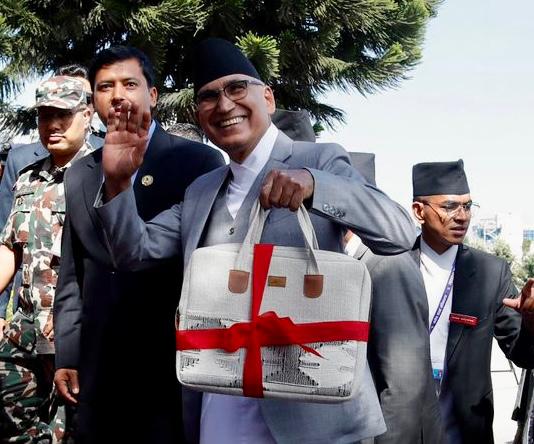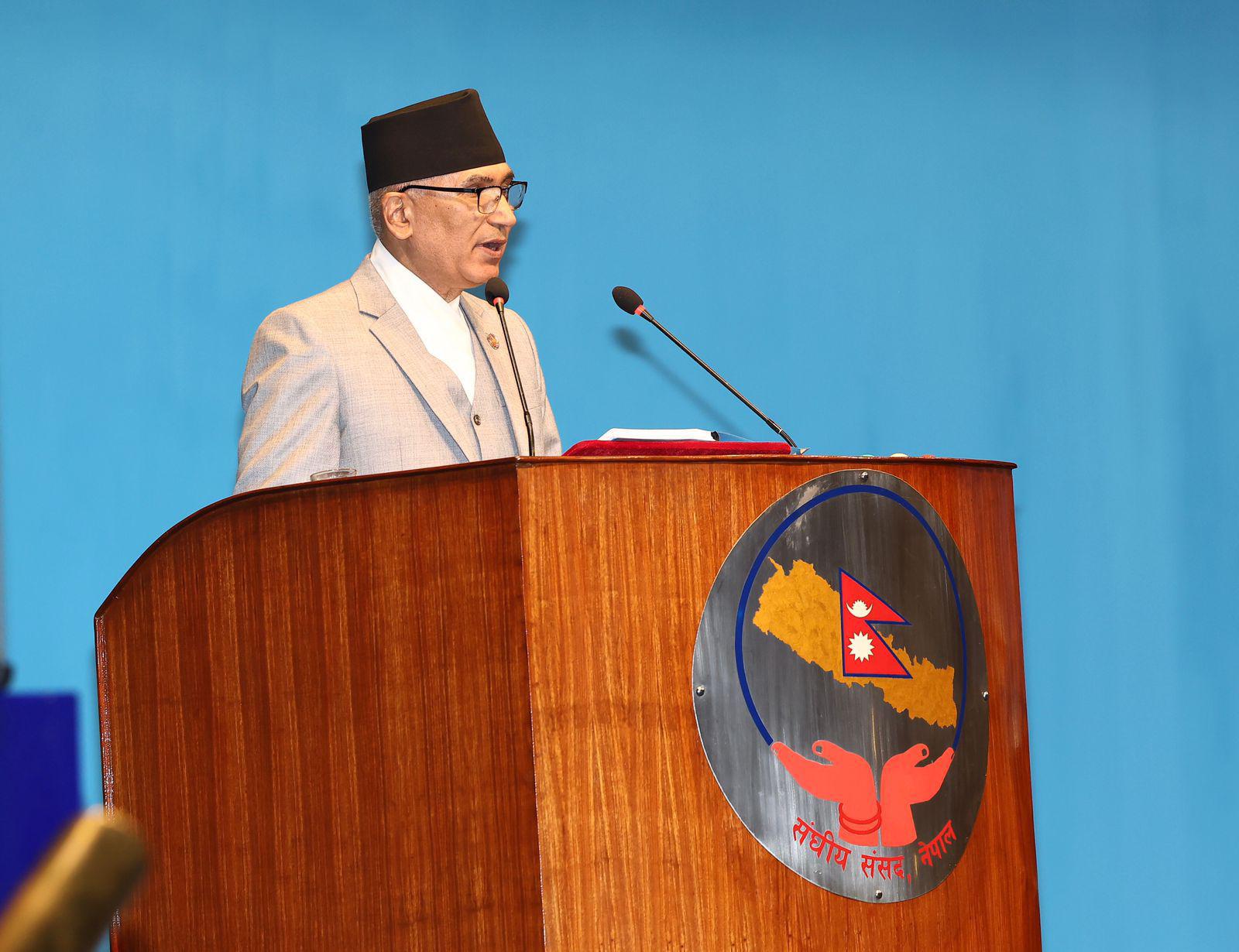Government of Nepal Announces Rs 1.96 Trillion Budget for Fiscal Year 2082/83 (2025/26)

Kathmandu – The Government of Nepal has presented a budget of Rs 1.96 trillion for the upcoming fiscal year 2082/83 (2025/26), which is 5.6 percent higher than the current year’s allocation. The new financial plan is geared towards achieving 6 percent economic growths while keeping inflation around 5.5 percent.
A major share of the budget has been directed toward reviving stalled development efforts. Rs 407.89 billion has been set aside for capital investment, aimed at upgrading the nation’s infrastructure and completing delayed construction works.
Meanwhile, day-to-day government operations, such as staff payments and administrative costs, will be covered by Rs 1.18 trillion, which makes up the largest portion of the budget. Another Rs 375.2 billion will be used to manage financial obligations, such as repaying loans and handling other fiscal responsibilities.
To support its spending plans, the government expects to generate Rs 1.31 trillion in internal revenue and receive Rs 53.45 billion from foreign grants. The remaining shortfall of Rs 595.66 billion will be covered by borrowing; Rs 233.66 billion from international sources and Rs 362 billion from domestic markets.
Although government employees won’t see an increase in their basic pay, the monthly cost-of-living allowance has been raised from Rs 2,000 to Rs 5,000. In a notable policy shift, the age threshold for receiving the senior citizen allowance has been raised to 70 years, from the earlier age of 60.
In a move to boost innovation and small businesses, the government has proposed Rs 730 million in concessional loans for startup ventures.
In a significant move to improve Nepal’s aviation infrastructure and strengthen its position as a global tourism destination, the government has earmarked Rs 4.15 billion in the upcoming fiscal year to modernise and rebrand Tribhuvan International Airport (TIA). This initiative is part of a broader plan to transform TIA into a “boutique airport”; a term used to describe a facility that offers a more refined, efficient, and traveler-friendly experience with improved services, aesthetic appeal, and better passenger management.
The planned upgrades will focus on enhancing both the physical infrastructure and the quality of services offered to domestic and international passengers. This includes expanding terminal spaces, improving baggage handling systems, upgrading immigration and customs facilities, and enhancing overall cleanliness and maintenance. Additionally, efforts will be made to incorporate advanced technology for smoother operations and to reduce wait times, particularly during peak hours.
Another key goal of the rebranding project is to present a more welcoming and modern image of Nepal to incoming tourists and investors. As the country’s primary international gateway, the state of Tribhuvan International Airport plays a crucial role in shaping visitors’ first impressions. By investing in aesthetic improvements, cultural showcases, and hospitality training, the government aims to create a more comfortable and memorable arrival and departure experience.
The rebranding effort also supports Nepal’s broader tourism development goals. With tourism being a key pillar of the national economy, especially in the post-pandemic recovery phase, improving airport infrastructure is essential for accommodating growing tourist numbers, encouraging repeat visits, and positioning Nepal as a competitive travel destination in South Asia.
Through this allocation, the government signals its commitment to raising standards in aviation and ensuring that the airport not only meets international benchmarks but also reflects the unique culture and hospitality that Nepal is known for.
In a continued effort to support children’s health, education, and overall well-being, the government has significantly increased its funding for key school-based welfare programmes in the fiscal year 2082/83. The school midday meal programme, which provides nutritious meals to students up to grade five in public schools, will receive an expanded budget of Rs 10.19 billion. This marks a substantial rise in investment, aimed at ensuring that approximately 2.8 million children across the country have access to at least one healthy meal during the school day.
The expansion of this initiative is intended not only to address malnutrition and improve students’ physical health but also to reduce school dropout rates, especially in rural and economically marginalized communities. Providing meals at school has proven to be an effective incentive for school attendance and can help improve academic performance by enhancing students’ ability to concentrate and learn.
Alongside this, the government is continuing its free sanitary pad distribution programme, with a dedicated allocation of Rs 1.29 billion. This initiative targets approximately 1.3 million schoolgirls, aiming to promote menstrual hygiene, reduce school absenteeism among adolescent girls, and create a more supportive and inclusive learning environment. The continuation and expansion of this programme reflect a growing recognition of the barriers girls face in accessing education and the importance of health and hygiene in overcoming them.
Together, these two programmes demonstrate the government’s commitment to improving equity in education, supporting vulnerable students, and addressing broader social determinants that influence learning outcomes. They also align with Nepal’s long-term goals of ensuring inclusive and quality education for all, as part of its commitments to the Sustainable Development Goals (SDGs).
As part of environmental protection efforts, the government plans to enforce a ban starting November 17 on plastic bags that are thinner than 40 microns, targeting the reduction of non-biodegradable waste. The Ministry of Forest and Environment has been allocated Rs 18.61 billion, reflecting the government’s commitment to environmental conservation and sustainable development.

The government has set aside Rs 2.6 billion in the upcoming fiscal year to advance the construction of two major tunnel road projects; the Nagdhunga and Siddhababa tunnels. These projects are expected to significantly improve transportation efficiency by easing traffic congestion, shortening travel times, and ensuring safer travel routes in the hilly terrain. Once completed, they will offer a reliable alternative to some of the country’s most accident-prone road sections, benefiting both commuters and freight movement.
In the energy sector, the government is working to strengthen Nepal’s electricity generation capacity. By the end of the fiscal year 2082/83, it aims to expand the country’s total installed capacity to 4,800 megawatts. This includes the addition of 942 megawatts of electricity through newly completed hydropower projects. This move is part of a broader plan to meet growing domestic energy demands, reduce dependency on imported electricity, and support export opportunities, especially during the peak production season.
In the upcoming fiscal year’s budget, the government has allocated Rs 57.48 billion to the agriculture sector, underscoring its strategic importance to Nepal’s economy and rural livelihoods. A significant portion of this budget is directed toward ensuring the timely and adequate supply of chemical fertilizers, which has long been a critical issue for farmers across the country. By improving fertilizer availability, the government aims to boost crop yields, enhance productivity, and reduce the country’s dependency on unpredictable import channels.
In addition to fertilizer distribution, the budget emphasizes the development of domestic production facilities. This initiative reflects a long-term vision to strengthen self-reliance in agricultural inputs, reduce import costs, and ensure stable supply chains. The establishment of local fertilizer plants is expected to not only meet national demand more efficiently but also create job opportunities and contribute to industrial growth within the agriculture-linked sectors.
These investments are part of a broader effort to ensure food security, stabilize agricultural markets, and support farmers with the resources they need to sustain and improve their livelihoods. The government’s focus on modernizing agriculture through better infrastructure, inputs, and support systems highlights its commitment to transforming this traditionally subsistence-based sector into a more resilient and productive foundation for economic development.
To promote the growth of Nepal’s information technology sector and encourage digital exports, the government has introduced significant tax incentives in the upcoming fiscal year. Companies engaged in IT-related services will benefit from a 75 percent exemption on their income tax obligations. This move is aimed at reducing operational costs and making the domestic tech industry more competitive on a global scale.
In addition, Nepali IT professionals who provide services to clients based outside the country will now be subject to a simplified tax structure. Instead of the regular progressive income tax system, they will pay a fixed and final tax rate of 5 percent on their income earned from foreign clients. This streamlined approach not only lessens the administrative burden on freelancers and small service providers but also encourages more professionals to engage in cross-border digital work. Through these reforms, the government hopes to boost digital entrepreneurship, create employment opportunities, and increase foreign currency earnings from the tech sector.
In a notable move to strengthen youth development and promote sports across the country, the government has allocated Rs 6.08 billion to the youth and sports sector in the budget for the fiscal year 2025/26. This is the highest amount ever designated for this sector, signaling a growing recognition of the important role that young people and athletic activities play in national development.
The allocation represents an increase of Rs 258 million compared to the current fiscal year, indicating a clear intent to expand programmes, improve facilities, and introduce new initiatives tailored to the needs of young citizens. This boost in funding is expected to support a wide range of activities, from grassroots sports development and infrastructure upgrades to youth skill-building programmes, leadership training, and community engagement projects.
A portion of the funds will likely go toward enhancing sports facilities, such as stadiums, training centers, and regional sports academies, to ensure that athletes at all levels have access to quality spaces to train and compete. Additionally, investments may be directed toward preparing athletes for national and international competitions, including providing better coaching, equipment, and support systems.
On the youth development side, the budget increase may support entrepreneurship programmes, innovation hubs, and initiatives that aim to empower young people with the skills and resources needed to contribute meaningfully to the economy and society. These efforts align with the government’s broader goals of reducing youth unemployment, fostering civic engagement, and creating an enabling environment for the younger generation to thrive.
Overall, the historic increase in funding for the youth and sports sector reflects a long-term vision to harness the potential of Nepal’s youth population and to promote physical well-being, national pride, and social inclusion through sports and developmental activities.
This year’s budget outlines a strategy that blends economic recovery and social responsibility, while maintaining careful control over inflation and public debt. The objectives and priorities of this year’s budget are given as:
(a) Achieve high, sustainable, and broad-based economic growth to reduce poverty.
(b) Generate employment by increasing productivity and expanding both public and private investment.
(c) Enhance economic capacity by promoting the use of modern technology.
(d) Establish social justice through structural and developmental means.
(e) Promote quality public services and good governance.
The fundamental development approaches are:
- Increase in productivity, employment, production, and overall productivity.
- Competitive and high-quality physical infrastructure and a skilled labor force.
- Qualitative improvement in the social sector.
(f) Ensure balanced development and social security.
(g) Deliver citizen-friendly services, control corruption, and implement governance reforms.



